Countryside & Beaches
Explore Zakynthos, its resorts, villages, countrysides and its beaches through our virtual tour to Zante island…
Of the forty-four villages of Zakynthos, most are developed but have maintained their traditional color. Tourism developed gradually and the environmental sensitivity of the inhabitants did not allow huge complexes to drown the beauty of the island. Here you will find large, medium-sized, and small hotels that offer not only modern comfort, but also service that becomes authentic hospitality.
Argassi, Gerakas, Porto Roma
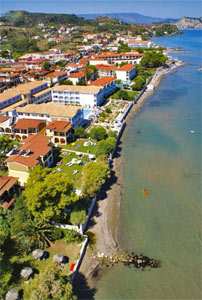
Starting from the seaside boulevard and heading in the direction of Agios Dionysios, at a distance of 4 km we meet the verdant Argassi, with its boundless sands and its clear sea. It is one of the most worldly areas of Zakynthos, providing a note of intense and lively nightlife. Around the area there are old churches and the ruins of a medieval tower, while the path leading to the peak of Skopos, where, according to mythology, Artemis, the goddess of the hunt, lived, starts out from there. There was a temple of Artemis at its peak, in whose place the monastery of Panagia Skopiotissa has been built.
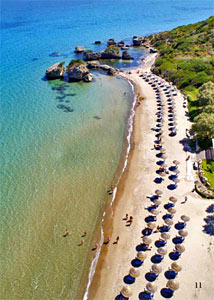 Returning to the coastal road and passing through the picturesque Xirokastello, a dirt road to the right leads to the unique beaches of Sekania and Dafni. These beaches constitute the most important areas of reproduction of the sea turtle Caretta – Caretta and for this reason all the measures for protection of the sea turtles are in force. Continuing in our original direction, and at a distance of 11 km from the town of Zakynthos, we meet the picturesque beach of Porto Zoro with the cliffs at its extreme right. The left end, which was recently renamed Rock with Flowers, is enclosed by
Returning to the coastal road and passing through the picturesque Xirokastello, a dirt road to the right leads to the unique beaches of Sekania and Dafni. These beaches constitute the most important areas of reproduction of the sea turtle Caretta – Caretta and for this reason all the measures for protection of the sea turtles are in force. Continuing in our original direction, and at a distance of 11 km from the town of Zakynthos, we meet the picturesque beach of Porto Zoro with the cliffs at its extreme right. The left end, which was recently renamed Rock with Flowers, is enclosed by
picturesque tavernas and rooms for rent. A few kilometers further away there is the shallow beach of Banana, which is considered one of the best and the most beautiful beaches of the island, since white sea carnations grow in its sand, providing an exotic picture.

Leaving Vasiliko, we arrive at the beach of Gerakas, which is located at the eastern extreme of Laganas Bay and also constitutes one of the reproduction sites for the sea turtle Caretta – Caretta. Southwest of Gerakas we find the privately owned island of Pelouzo, where we find ruins of the monastery that used to exist there at one time. At the end of this route, we meet Porto Roma, a very picturesque promontory with excellent sand, clean water, and a small harbor for small boats, which is recommended for the lovers of sailing.
Zakynthos – Kalamaki – Laganas – The Beach of Limni Keriou – Marathonisi, Keri – Agalas
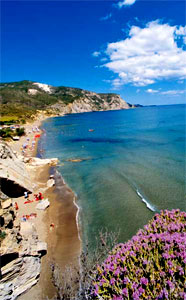 Following the road that leads to the airport, at a distance of 8 km we find Kalamaki, one more tourist area of Zakynthos. The wide beach, with the tall cliffs at its edge, is covered with sand dunes or ammokouloumoi, as the people of Zakynthos call them. Sea carnations grow in this sand, providing the entire area with an exotic note. To the left of the beach there are impressive gypsum cliffs, known as the Gypsolithoi or Ypsolithoi. Immediately afterwards, the road leads to the most important tourist resort of the island, Laganas, with one of the largest beaches in Greece, with a length of 9 km. It is one of the most populated and frequented areas of Zakynthos. Afterwards, we meet the beautiful beach of Agios Sostis and the beach of Porto Koukla, where the vegetation literally touches the light blue water.
Following the road that leads to the airport, at a distance of 8 km we find Kalamaki, one more tourist area of Zakynthos. The wide beach, with the tall cliffs at its edge, is covered with sand dunes or ammokouloumoi, as the people of Zakynthos call them. Sea carnations grow in this sand, providing the entire area with an exotic note. To the left of the beach there are impressive gypsum cliffs, known as the Gypsolithoi or Ypsolithoi. Immediately afterwards, the road leads to the most important tourist resort of the island, Laganas, with one of the largest beaches in Greece, with a length of 9 km. It is one of the most populated and frequented areas of Zakynthos. Afterwards, we meet the beautiful beach of Agios Sostis and the beach of Porto Koukla, where the vegetation literally touches the light blue water.
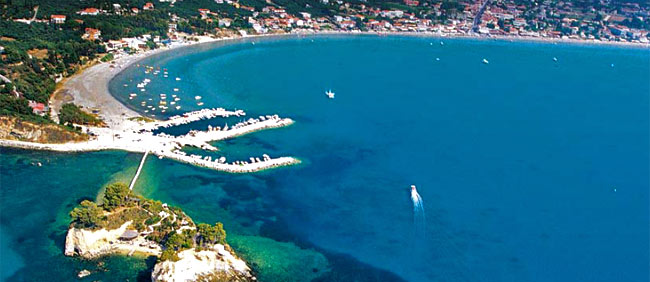
We should not forget that the Bay of Laganas is subject to protective measures for the Caretta – Caretta. The beauty that gushes forth as you look at the beach is unique; it is no coincidence that the turtles prefer Laganas for their reproduction. Leaving the Bay of Laganas, we head west, towards the interior of the island, to Lithakia,where with a deviation of 5 km in the direction of Agalas, after passing through the village with its picturesque stone houses, the road leads to the cave of Damianos. Furthermore, on the mountain, above the gorge of Avyssos there is the so-called “Human Cave”, which, as it is said, was made into a grave for 150 people by pirates.

On the road to Keri we meet the beach of Limni Keriou. This is the coastal settlement with the most beautiful and picturesque beach in Zakynthos, opposite the enchanting Marathonisi. The picturesque small harbour of Limni Keriou is the famous harbor of ancient Zakynthos, known to all in antiquity, which constituted a noteworthy commercial port for the entire island. In the same area there is also “the spring of Herodotus”, known since antiquity, with water that gushes out from the earth even today. From here, the ships and fishing boats set out for the brief enjoyable cruises to visit the long-living sea turtle Caretta – Caretta, the beaches of Marathonisi, and the famous blue caves of Keri, with its emerald green water and the amazing Arches of Marathias (the small and the large arch), which consist of arches formed by the cliffs above the sea, under which the small boats pass. At the beach of Marathias, the pebbles and the deep water will charm you, since they offer a distinct sensation of calm and tranquility.
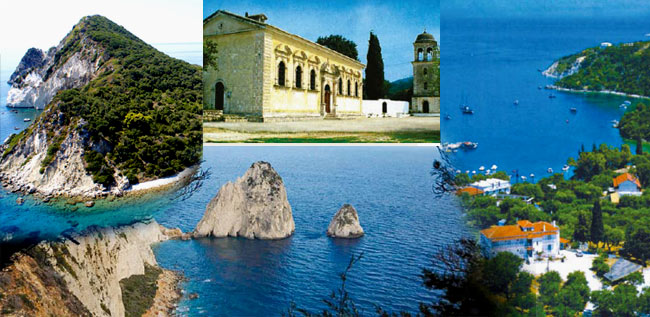
Just 5 km farther on, in a verdant landscape, we find Keri, with its stone houses and narrow alleys, which offers a unique and outstanding view. In the village there is also the noteworthy church of Panagia Keriotissa, with its amazing iconostasis. 1.5 km in the direction of the villgae, at the edge of a precipice of 200 meters, there is the lighthouse of Keri, with its excellent view of the two huge white cliffs of Megali Myzithra and Mikri Myzithra, which stand out above the sea like pyramids. From this point you can also admire one of the most famous sunsets of the Ionian Sea. The Ionian Sea spreads before your eyes and the colors of the sunset create a harmonious scene with the abrupt slope and the calm water, red from the reflection. To the southeast there is the deepest point of the Mediterranean basin, the “Well of Oinousses”, with a depth of approximately 4,500 meters.
Zakynthos – Macherado – Agios Leon – Navagio

Just 10 km west of Zakynthos town we find Macherado, the second largest village in Zakynthos after Katastari. The church of Agia Mavra, in the style of a simple basilica, is impressive, standing out from afar among the cypresses with
its Venetian bell tower, whose bells are said to be the most melodious in Greece. The church was destroyed by a large
forest fire at the beginning of the year 2006. The work for its restoration has already begun.
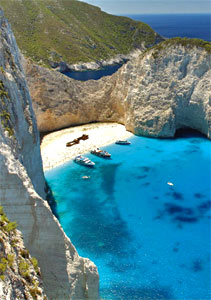 To the southwest, as we ascend the mountain we meet the village of Agios Nikolaos or Koiliomeno, at an elevation of 480 meters, where the impressive bell tower of Agios Nikolaos is located, dating from around 1893, as well as traditional houses from the 16th century. Between Koiliomeno and Lagopodo there is the area called “The Garden of the Orchids” by botanists, because of the 42 species of orchids that grow on the island. The vegetation on the island is rich and unique; along our journey the pines, cypresses, the lentisks, the holly oaks, and very many plants and shrubs enchant and impress us.
To the southwest, as we ascend the mountain we meet the village of Agios Nikolaos or Koiliomeno, at an elevation of 480 meters, where the impressive bell tower of Agios Nikolaos is located, dating from around 1893, as well as traditional houses from the 16th century. Between Koiliomeno and Lagopodo there is the area called “The Garden of the Orchids” by botanists, because of the 42 species of orchids that grow on the island. The vegetation on the island is rich and unique; along our journey the pines, cypresses, the lentisks, the holly oaks, and very many plants and shrubs enchant and impress us.
Leaving Agios Nikolaos behind us and turning to the right, we are hading towards Agios Leon, with a view towards the sea that enchants us. One kilometer before it, there are the mountain villages of Louha and Gyri, which are hidden within the vegetation and whose traditional architecture intensely resembles that of the villages of Mani, possible because its first inhabitants came from the Peloponeese. From Gyri the road leads to the unexplored cave of Chagiotis and to Mavri Spilia. As we reach the village of Agios Leon, we find the church of the same name, an impressive example of unique popular architecture, with the use of the lower part of a windmill as a bell tower.
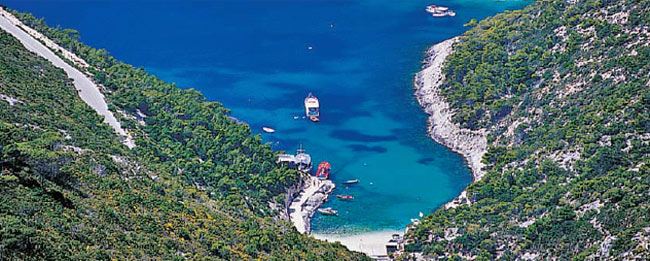
To the left, at a distance of 3 km, we find Kambi, which is built on the abrupt precipice of Shiza. In the area there is a Mycenaean cemetery with hewn caves. Opposite the coast there is the island of Fokia, which owes its name to the similarity of its shape to that of a seal. The village of Maries, which we meet after Exo Chora, took its name from Mary Magdalene. The view from the peak of Vrachionas, which reaches Kefallonia, is amazing.
Zakynthos – Tsilivi – Alykes – The Blue Cave
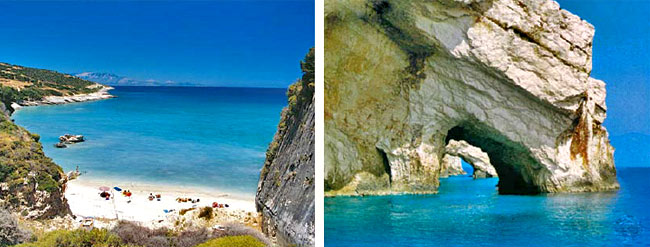
Immediately afterwards, the most beautiful point on the island, Navagio, with its famous beach, known to all, is ready to enchant you. This unique landscape, surrounded by rocky white slopes, vegetation, and the abundant sand that leads to the emerald green water of the Ionian Sea, is the ideal place for a romantic journey by night, in spite of the multitude of people that you may meet.
A few kilometers farther away there is the picturesque enclosed promontory of Porto Vromi, where we recommend that you rent a pedal boat or a boat in order to explore the surrounding caves. There are boats that travel from the small harbor to the beach of Navagio; the trip lasts half an hour and the captain makes stops at the caves with deep blue water and white sand for anyone that wants to swim. Do not forget to bring water. Before Navagio there are also other idyllic beaches, which, however, require a boat of your own for a visit.

In the direction of Bochalis, at a distance of 1 km , the road to the right leads to Stranis Hill and afterwards to Akrotiri, an area full of vegetation, where the notables of the island chose to build their country houses. The country house of Dionysios Solomos is found in the same area; together with the other mansions, they constitute architectural treasures from the past. Opposite the shore there is the small island of Vodi, which used to be joined to the land by a small bridge. To the left there is the village of Bochalis with the Fortress, while if we go straight ahead we will meet Tsilivi,
one of the most beautiful beaches in Zakynthos, with an outstanding sandy shore that attracts many visitors. After Tsilivi there is the picturesque Planos, an ideal choice for swimming, since its water is crystal clear, shallow, and safe. If we return to the main road towards Alykes, we will meet roads that lead to small beaches and inlets, ready to satisfy ever demanding visitor: Amboula, Pahyammos, Drosia, Psarrou, and Ammoudi.
At a distance of 2 km there is the beach of Alikana, where excavations in the wider area of the settlement have brought to light a domed tomb and vases from the Mycenaean period. At the promontory of Agia Kyriaki there is the picturesque beach of the same name with its fine sand, and immediately afterwards, the famous and excellent Alykes.
Alykes’ beautiful and extensive beach and shallow sea have classified it among the best of the island. Behind the village
there are the salt lakes, which used to form the base of the local economy. The road to the right leads to the village of Orthonies. As we leave and follow the road to the left, we meet Kato and Ano Volimes, which are famous for their excellent woven goods and embroidery. At a distance of 9 km, there is the small harbor of Agios Nikolaos, from which the boats for the Blue Cave start, and there is also a ferry to Kefallonia.
Strofades
Deep in the water of the Ionian Sea, 45 km southwest of Zakynthos town and 78 km west of the promontory of Katakolo in the Peloponnese, two small and isolated islands, the Strofadia, stand out. The ancients called them the “Floating Islands” because they truly seem to float. The larger island is called Stamfani and the smaller one Arpya. The two islets are connected to each other by an underwater isthmus. On Stamfani there is a lighthouse and the monastery of Metamorfosi or of Panagia Pandohara, which was founded during the Byzantine Empire, in 1241. Saint Dionysius, the
patron saint of the island of Zakynthos, had been a monk in this monastery. The monastery is impressive and imposing at the same time it looks like a medieval fortress with walls over 25 meters high, evidently for protection from incursions by pirates.




 Admiral Hotel
Admiral Hotel